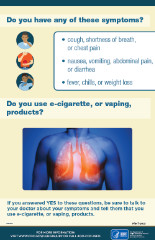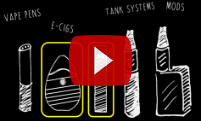Resources & Publications

Publications and resources related to e-cigarette, or vaping, product-use associated lung injury (EVALI) are available for the public, healthcare providers, and state and local health departments.
CDC Resources
- E-cigarettes and Youth: What Parents Need to Know [PDF – 1 MB]
- Get the facts about electronic cigarettes, their health effects and the risks of using e-cigarettes
- What’s the Bottom Line About Electronic Cigarettes?
- What’s the Bottom Line on the Risks of E-cigarettes for Kids, Teens, and Young Adults?
- Marijuana and Public Health
FDA Resources
- Want to Quit Smoking? FDA-Approved Products Can Help
- FDA-Approved Medications for Smoking Cessation [PDF – 234 KB]
Substance Abuse and Mental Health Services Administration Resources
Quitting Resources
- SmokeFree.gov
- Smokefree Teen
- How to Quit Smoking
This CDC web page provides free resources, including the quitSTART app and how to build a quit plan. - Truth Initiative
Clinical Resources
Algorithm for Management of Patients with Respiratory, Gastrointestinal, or Constitutional Symptoms and E-cigarette, or Vaping, Product Use (12/20/2019) [print-only PDF – 120 KB]
The purpose of this algorithm is to provide a brief summary of the Update: Interim Guidance for Health Care Professionals Evaluating and Caring for Patients with Suspected E-cigarette, or Vaping, Product Use–Associated Lung Injury and for Reducing the Risk for Rehospitalization and Death Following Hospital Discharge — United States, December 2019.
EVALI Discharge Readiness Checklist [PDF – 110 KB]
This checklist can be used to assist with planning towards the safe discharge of patients hospitalized with EVALI.
Don’t Forget to Ask: Assessing the Risk of Lung Injury in Patients Using E-Cigarette, or Vaping, Products [PDF – 129kb]
This fact sheet covers best practices for assessing the risk of lung injury in patients using e-cigarette, or vaping, products. Learn how to ask patients about e-cigarette, or vaping, product use.
Case Study: A Teen With Cough: Could This Be Vaping Related?
Early diagnosis of EVALI and appropriate treatment remains critical to improving patient outcomes. Challenge yourself with a Medscape Case Study that illustrates key EVALI evaluation and treatment scenarios.
International Classification of Diseases, Tenth Edition, Clinical Modification (ICD-10-CM)-Supplement [PDF – 160 KB]
The purpose of this document is to provide official diagnosis coding guidance for healthcare encounters related to the 2019 healthcare encounters and deaths related to e-cigarette, or vaping, product use associated lung injury (EVALI). This guidance is consistent with current clinical knowledge about disorders associated with the use of e-cigarette, or vaping, products.
Specimen Guidance
Laboratory Clinical Sample Collection and Storage Guidance for E-Cigarette, or Vaping, Product Use-Associated Lung Injury (EVALI)[PDF – 246 KB]
The purpose of this document is to provide general clinical specimen collection and storage guidance for healthcare providers and public health laboratory personnel involved in the care of patients who meet, or are highly suspected of meeting, the case definition for EVALI.
Clinician Outreach and Communication Activity (COCA)
COCA Webinar – Update: Interim Guidance for Healthcare Providers regarding the Management Approach of Patients with Suspected E-cigarette, or Vaping, Product Use-Associated Lung Injury (EVALI)
On November 21, 2019, CDC experts described updates to prior interim recommendations for U.S. healthcare providers evaluating and managing patients with suspected or known lung injury associated with e-cigarette, or vaping, product use, with particular considerations for outpatient management and for influenza season, as published in MMWR on November 19, 2019.
- Presentation in PDF [PDF – 2.5 MB]
COCA Webinar – Update: Interim Guidance for Health Care Providers Evaluating and Caring for Patients with Suspected E-cigarette or Vaping Product Use Associated Lung Injury
On October 17, 2019, CDC experts described updates to prior interim recommendations for U.S. healthcare providers caring for patients with suspected or known lung injury associated with e-cigarette or vaping products as published in MMWR on October 11, 2019.
- Presentation in PDF [PDF – 3 MB]
COCA Webinar – Outbreak of Lung Injury Associated with E-cigarette Product Use or Vaping: Information for Clinicians
On September 19, 2019, CDC experts described e-cigarette and vaping terminology related to e-cigarette, or vaping, products; summarized frequent Clinical, Laboratory, Radiographic, and Pathologic Findings and Outcomes among cases; and discussed recommendations for clinicians.
- Presentation in PDF [PDF – 2 MB]
Poster for Clinical Settings
This Poster for Clinical Settings is available in English and Spanish for use in healthcare settings to encourage conversation between patients and providers about their use of e-cigarette, or vaping, products.
- Poster in English [print-only PDF – 299 KB]
- Poster in Spanish [print-only PDF – 296 KB]
CDC Resources
-
- E-cigarette, or Vaping, Products Visual Dictionary [PDF – 3.3 MB]
- Get the facts about electronic cigarettes, their health effects and the risks of using e-cigarettes
- E-cigarettes and Youth: What Health Care Providers Need to Know [PDF – 975 KB]
- E-cigarettes shaped like USB flash drives: Information for Parents, Educators, and Health Care Providers
- Marijuana and Public Health
Healthcare Provider Resources, Office on Smoking and Health
Resources from the Surgeon General
EVALI Public Service Announcement
This public service announcement (PSA) and script provides information about EVALI. The script and PSA can be used for “live ads” or for radio stations or media outlets by states or other partners.
Lung Injury Associated with E-cigarette Use or Vaping National Case Form [print-only PDF – 264 KB]
(also available in Spanish [print-only PDF – 304 KB])
The purpose of this document is to provide guidance for local and state health departments to report any probable or confirmed patient case of EVALI and transmit data to CDC using the Data Collection and Integration for Public Health (DCIPHER) platform, or by contacting CDC at EVALI@cdc.gov.
Laboratory Clinical Sample Collection and Storage Guidance for E-Cigarette, or Vaping, Product Use-Associated Lung Injury (EVALI)[PDF – 246 KB]
The purpose of this document is to provide general clinical specimen collection and storage guidance for healthcare providers and public health laboratory personnel involved in the care of patients who meet, or are highly suspected of meeting, the case definition for EVALI.
Video: E-Cigarette 101
The Association of State and Territorial Health Officials (ASTHO) and CDC’s Office on Smoking and Health (OSH) recently developed a video with CDC expert Dr. Brian King giving an ‘e-cigarette 101’ talk for clinicians and public health professionals.
CDC Resources
- E-cigarette, or Vaping, Products Visual Dictionary [PDF – 3.3 MB]
- Get the facts about electronic cigarettes, their health effects and the risks of using e-cigarettes
- Marijuana and Public Health
FDA Resources
Hospitalizations and Deaths Associated with EVALI
This report compares the characteristics of patients with fatal cases of EVALI with those of patients with nonfatal cases to improve the ability of clinicians to identify patients at increased risk of death from the condition. Data show that chronic conditions, including cardiac and respiratory diseases and mental health conditions, were common among hospitalized patients with EVALI.
Update: Characteristics of a Nationwide Outbreak of E-cigarette, or Vaping, Product Use–Associated Lung Injury — United States, August 2019–January 2020
This report updates patient demographic characteristics, self-reported substance use, and hospitalization dates for EVALI patients reported to CDC by states, as well as the distribution of emergency department (ED) visits related to e-cigarette, or vaping, products. Data show that ED visits related to e-cigarette, or vaping, products continue to decline, after sharply increasing in August 2019 and peaking in September.
Characteristics of Persons Who Report Using Only Nicotine-Containing Products Among Interviewed Patients with E-cigarette, or Vaping, Product Use–Associated Lung Injury — Illinois, August–December 2019
This report examines EVALI patients who report using only nicotine-containing e-cigarette, or vaping, products in Illinois. Findings suggest that the contributing cause or causes of EVALI for individuals reporting use of only nicotine-containing products warrants further study.
Update: Product, Substance-Use, and Demographic Characteristics of Hospitalized Patients in a Nationwide Outbreak of E-cigarette, or Vaping, Product Use–Associated Lung Injury — United States, August 2019–January 2020
This report updates patient demographic characteristics, self-reported substance use, and e-cigarette, or vaping, product sources reported to CDC as of January 7, 2020. Findings strengthen the association between EVALI and the use of THC-containing e-cigarette, or vaping, products obtained from informal sources.
Update: Interim Guidance for Health Care Professionals Evaluating and Caring for Patients with Suspected E-cigarette, or Vaping, Product Use–Associated Lung Injury and for Reducing the Risk for Rehospitalization and Death Following Hospital Discharge — United States, December 2019
This guidance document provides updates to prior interim guidance for U.S. healthcare providers evaluating and caring for patients with suspected EVALI, with particular considerations for discharge planning and optimized follow-up and case management after discharge.
Characteristics of Patients Experiencing Rehospitalization or Death After Hospital Discharge in a Nationwide Outbreak of E-cigarette, or Vaping, Product Use–Associated Lung Injury Lung Injury — United States, 2019
This is the first report that analyzes factors that may increase risk for rehospitalization and death among EVALI patients following hospital discharge. These findings helped inform updates to clinical guidance for healthcare professionals.
Vitamin E Acetate in Bronchoalveolar-Lavage Fluid Associated with EVALI
This study analyzed bronchoalveolar lavage (BAL) fluid samples from EVALI cases and a comparison group of healthy people, demonstrating that vitamin E acetate is closely associated with EVALI.
Syndromic Surveillance for E-Cigarette, or Vaping, Product Use–Associated Lung Injury
This report analyzed syndromic data on emergency department visits associated with possible EVALI. Data suggest that the EVALI outbreak began in June 2019 and cases have been declining since a peak in September.
Update: Demographic, Product, and Substance-Use Characteristics of Hospitalized Patients in a Nationwide Outbreak of E-cigarette, or Vaping, Product Use–Associated Lung Injuries — United States, December 2019
This is the first report that analyzes national data on use of THC-containing product brands by patients with e-cigarette, or vaping, product use-associated lung injury (EVALI).
Characteristics of E-cigarette, or Vaping, Products Used by Patients with Associated Lung Injury and Products Seized by Law Enforcement — Minnesota, 2018 and 2019
This is the first report presenting chemical analytic results on products obtained from EVALI patients and on products intended for the illicit market both before and during the outbreak. These data further support a potential role for vitamin E acetate in the EVALI outbreak.
Update: Interim Guidance for Health Care Providers for Managing Patients with Suspected E-cigarette, or Vaping, Product Use-Associated Lung Injury — United States, November 2019
This guidance document provides updates to prior interim recommendations for U.S. healthcare providers evaluating and managing patients with suspected or known lung injury associated with e-cigarette, or vaping, product use, with particular considerations for outpatient management and for influenza season.
If you have questions about CDC’s investigation into the lung injuries associated with use of electronic cigarette, or vaping, products, contact CDC-INFO or call 1-800-232-4636.

